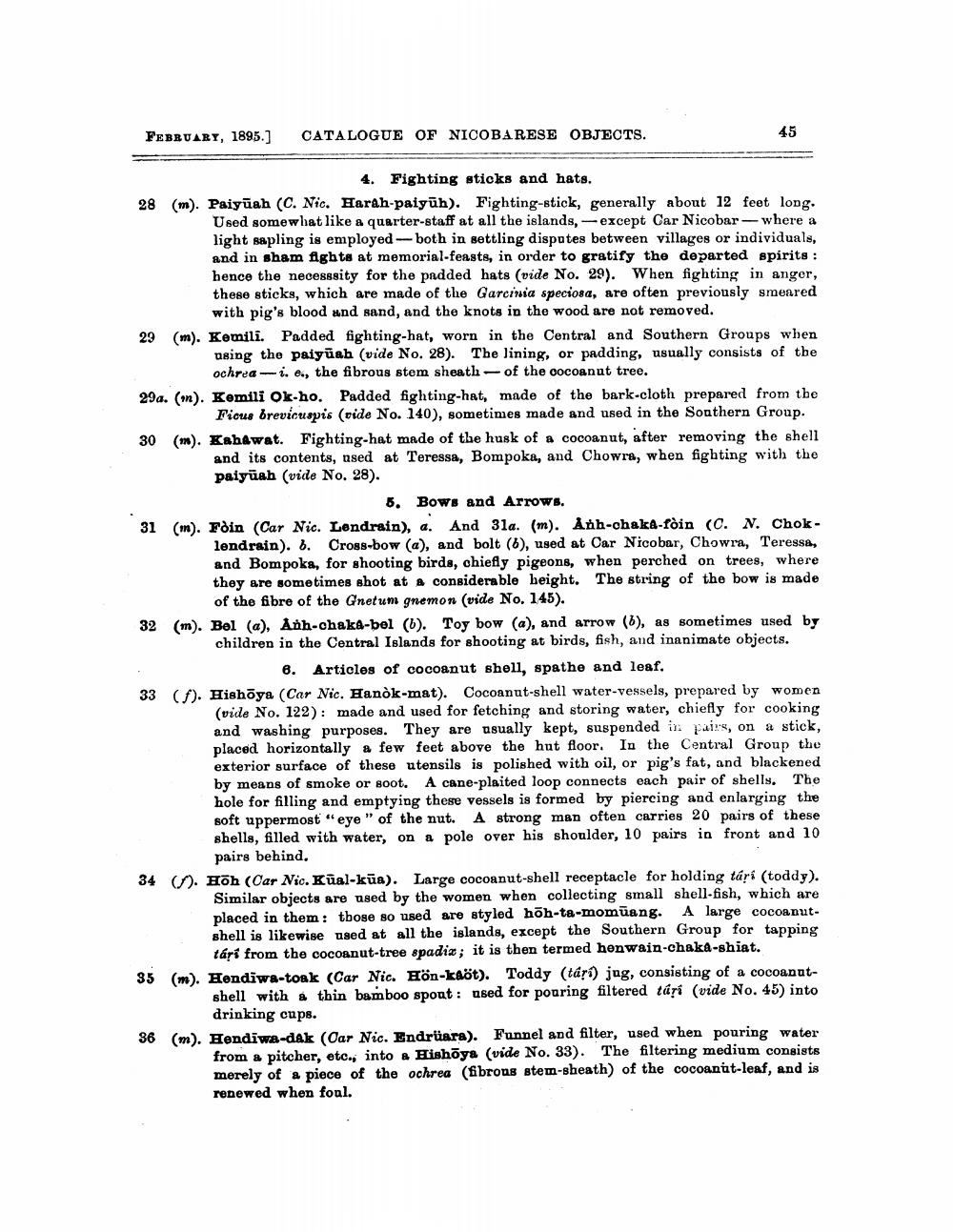________________
45
FEBRUARY, 1895.] CATALOGUE OF NICOBARESE OBJECTS.
4. Fighting sticks and hats.
28 (m). Paiyuah (C. Nic. Harah-paiyuh). Fighting-stick, generally about 12 feet long. Used somewhat like a quarter-staff at all the islands, -except Car Nicobar - where a light sapling is employed-both in settling disputes between villages or individuals, and in sham fights at memorial-feasts, in order to gratify the departed spirits: hence the necesssity for the padded hats (vide No. 29). When fighting in anger, these sticks, which are made of the Garcinia speciosa, are often previously smeared with pig's blood and sand, and the knots in the wood are not removed.
29 (m). Kemili. Padded fighting-hat, worn in the Central and Southern Groups when using the paiyuah (vide No. 28). The lining, or padding, usually consists of the ochreai. e, the fibrous stem sheath of the cocoanut tree.
29a. (m). Kemili Ok-ho. Padded fighting-hat, made of the bark-cloth prepared from the Ficus brevicuspis (vide No. 140), sometimes made and used in the Southern Group.
30 (m). Kahawat. Fighting-hat made of the husk of a cocoanut, after removing the shell and its contents, used at Teressa, Bompoka, and Chowra, when fighting with the paiyuah (vide No. 28).
5. Bows and Arrows.
31 (m). Fòin (Car Nic. Lendrain), a. And 31a. (m). Anh-chaka-fòin (C. N. Choklendrain). 6. Cross-bow (a), and bolt (6), used at Car Nicobar, Chowra, Teressa, and Bompoka, for shooting birds, chiefly pigeons, when perched on trees, where they are sometimes shot at a considerable height. The string of the bow is made of the fibre of the Gnetum gnemon (vide No. 145).
32 (m). Bel (a), Anh-chaka-bel (b). Toy bow (a), and arrow (b), as sometimes used by children in the Central Islands for shooting at birds, fish, and inanimate objects.
6. Articles of cocoanut shell, spathe and leaf.
33 (f). Hishōya (Car Nic. Hanòk-mat). Cocoanut-shell water-vessels, prepared by women (vide No. 122): made and used for fetching and storing water, chiefly for cooking and washing purposes. They are usually kept, suspended in pairs, on a stick, placed horizontally a few feet above the hut floor. In the Central Group the exterior surface of these utensils is polished with oil, or pig's fat, and blackened by means of smoke or soot. A cane-plaited loop connects each pair of shells. The hole for filling and emptying these vessels is formed by piercing and enlarging the soft uppermost "eye" of the nut. A strong man often carries 20 pairs of these shells, filled with water, on a pole over his shoulder, 10 pairs in front and 10 pairs behind.
34 (). Hōh (Car Nic. Kual-kua). Large cocoanut-shell receptacle for holding tari (toddy). Similar objects are used by the women when collecting small shell-fish, which are A large cocoanutplaced in them: those so used are styled hōh-ta-momuang. shell is likewise used at all the islands, except the Southern Group for tapping társ from the cocoanut-tree spadix; it is then termed henwain-chaka-shiat.
35 (m). Hendiwa-toak (Car Nic. Hön-kaöt). Toddy (tár) jug, consisting of a cocoanutshell with a thin bamboo spout: used for pouring filtered tari (vide No. 45) into drinking cups.
36 (m). Hendiwa-dak (Car Nic. Endrüara). Funnel and filter, used when pouring water from a pitcher, etc., into a Hishoya (vide No. 33). The filtering medium consists merely of a piece of the ochrea (fibrous stem-sheath) of the cocoanut-leaf, and is renewed when foul.




